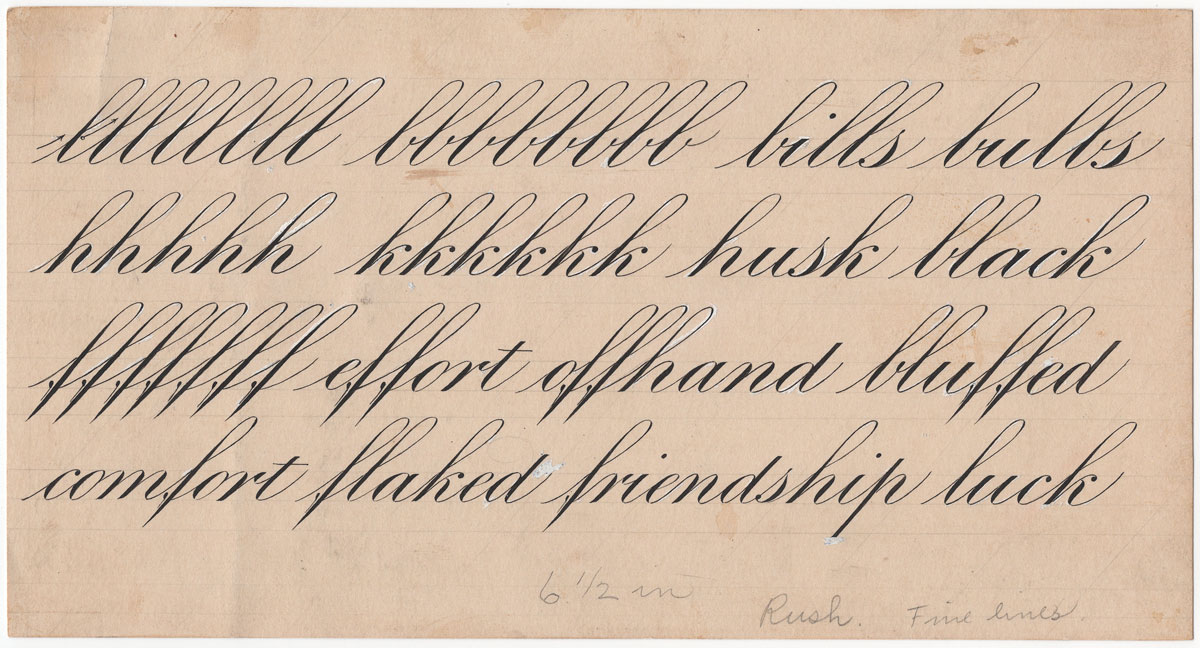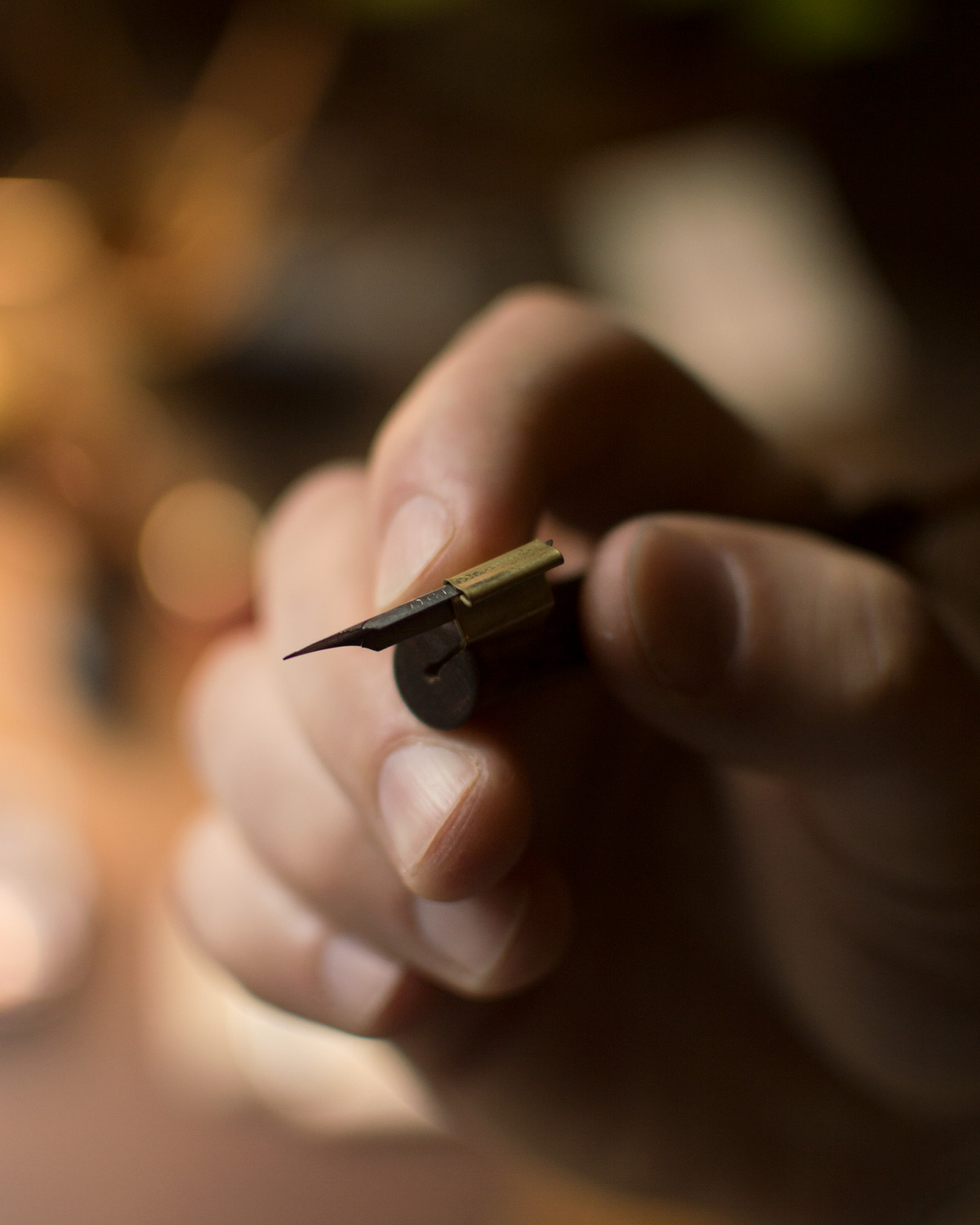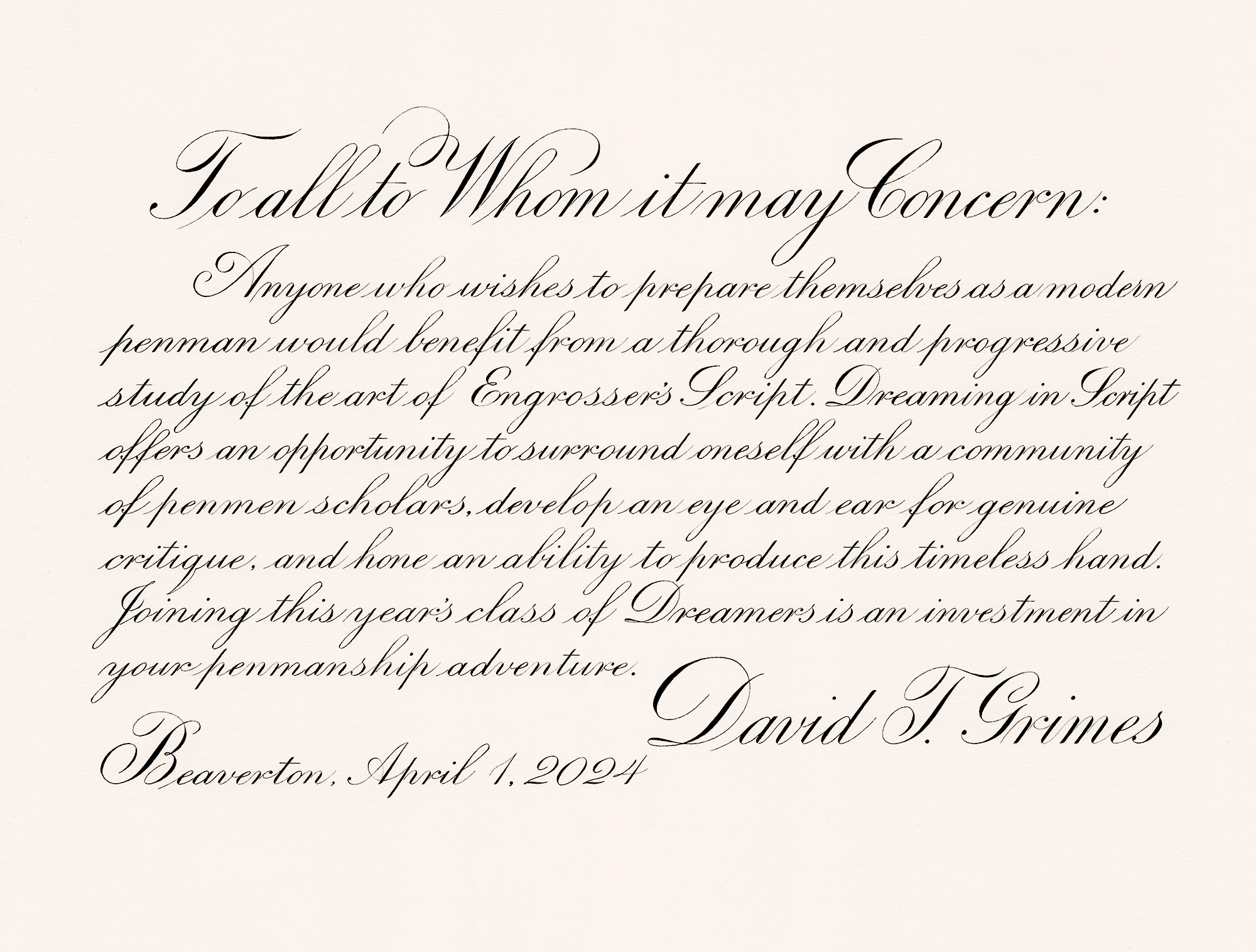What is Engrosser’s Script?
Engrosser’s Script is a style of American calligraphy developed during the late 19th century. It is formed with a flexible, pointed steel pen and an oblique penholder using careful movements of the fingers, hand, and wrist. This historic style of writing is renowned for its geometric precision and timeless beauty.

E. A. Lupfer, lessons in Modern Engrosser’s Script – No. 6, 1937. Masgrimes Archive.
Visually, ES is similar to its parent script family: English Roundhand. It is a cursive script, the letters being connected to one another with precisely constructed hairlines and meticulous horizontal spacing. The forms generally slant to the right at about 55° (when measured from the baseline), although varieties of slant in each direction do occur.
Table of Contents
How is Engrosser’s Script different from English Roundhand?
This is a tricky question, as there are many varieties of English Roundhand. Generally speaking, Engrosser’s Script differs from English Roundhand in a few specific ways:
- ES is not a “cursive” script in the true sense. The letters consist of assembled strokes between which the pen is lifted from the paper. This is known as “modularity,” and gives Engrosser’s Script a distinctive look if the gaps between strokes are not carefully eliminated through retouching or high-fidelity execution. English Roundhand was typically written with fewer lifts of the quill.
- Fine specimens of Engrosser’s Script demonstrate angularity in their letter shapes which contrasts heavily when compared to the curves of English Roundhand from centuries prior. This angularity is most common in the interior structures of the rounded forms (a, c, d, e, &c.) and is thus referred to as “interior angularity.” Some say that this quality is akin to “engraving on paper.”
- Engrosser’s Script’s forms are shaped by the abilities of a steel pen point—a writing instrument that was uncommon before the 1800s[1]. Certain strokes in ES are difficult to execute with a quill pen due to their precise geometry. Inversely, the quills that were commonly used in the century prior to Engrosser’s Script’s development could produce pushed shades. The pointed steel pen cannot replicate pushed shades naturally, so they must be synthesized with additional pulled strokes.

L. Fields, Zanerian Engrosser’s Script Certificate, 1923. This specimen demonstrates excellent modularity and interior angularity. Scan courtesy of Chris Yoke
How do I write Engrosser’s Script?
Typically, Engrosser’s Script is written with deliberate finger, hand, and wrist motions. The slow, rhythmic pacing by which letters are formed allows the penman to produce shades that are both geometrically refined and joined together with a high degree of exactness known as “fidelity.” The pen is lifted between each stroke to allow its tines to reset and be cleared of any paper fibers of debris before the next mark is made.
An oblique pen holder is the tool of choice for the Engrosser’s Script penman. The uniquely offset flange of the oblique pen allows for the shades of Engrosser’s Script to be drawn directly towards the body, which increases the likelihood of staying on slant. The oblique pen should be “scientifically adjusted,” as the old penmen used to say. This means that the flange should be inclined slightly so that the pen lays flatter to the page when writing. It is my preference to roll the pen slightly to the right as well.
Pen customization is a very personal thing and will depend largely on your preferences, hand size, writing position, and more. Beginners should secure an oblique pen holder with a simple brass flange so that adjustments can be made with the fingers. Certain types of pen holders may not accept adjustments without significant force. If your flange is glued into your holder, or you are using some kind of unique flange, ask your pen maker for their advice regarding adjustment.

A view of an adjusted oblique pen flange. Note the slight incline that lowers the pen to the paper when placed in a writing position.
Common Aliases
Many people are confused about the differences between “Engrosser’s Script” and other names for similar styles of calligraphy. The distinctions between a few of the most common aliases used in place of Engrosser’s Script are simple to outline.
Roundhand / Round Hand
The term “Roundhand” functions best when used as an umbrella term for a variety of different styles of calligraphy. When compared with ES, the most commonly pictured type of Roundhand is English Roundhand, which is the direct English predecessor to the Engrosser’s Script utilized in America.
It should be noted that during a transitional time in the development of Engrosser’s Script, both “Roundhand” and “Engrosser’s Script” were used in the influential work of E. A. Lupfer titled The Zanerian Manual (1924). Thus, one is not incorrect to use the term in reference to ES.
To learn more about the evolution of Roundhand in England, prior to the development of Engrosser’s Script, check out Sybille van Zuylen’s Bibliography of European Copybooks, or find a copy of The English Writing Masters and Their Copy-books (1962).
Engraver’s Script
“Engraver’s Script” is a term used frequently by penmen of the early 20th century to refer to this style of writing. This choice of words is in reference to the script of engraving professionals that employed large amounts of highly-refined geometric modular shaded script in their designs for insurance policies, stock certificates, currency, etc.
The term “Engraver’s Script” was further solidified by the American titles such as Lessons in Engraver’s Script Penmanship (Jones, 1911), which shows a style of writing quite consistent with that found in The Zanerian Manual, and Lessons in Advanced Engraver’s Script (Pub. Jones, Plates by Madarasz & Martin), which boasts shaded capital letters executed in an ornamental style and a more rapid method of execution.
Some contemporary practitioners choose to call their work “Engraver’s Script” because it is widely considered to resemble engraving on paper.
Copperplate
The term “Copperplate” is used in connection with fancy cursive handwriting, but the merits of conflating the term with Engrosser’s Script fall short on two simple principals:
- Copperplate is already a term used in connection with the Intaglio printing process, which can be used to print any variety of designs, including pictures, text, technical drawings, etc.
- Over the last century, Copperplate has been used as a contemporary term to include all variety of shaded round writing, and thus includes so many styles in general that it no longer accurately defines anything specific.
Choosing the right name
While there are various names commonly used in place of ES, we must be discerning when we select which term(s) we choose to use to refer to our own practice or in conversations with others. There are distinctions between the various names, and fostering deeper understanding of the origins of such names helps to preserve the history and unique qualities that make Engrosser’s Script such a beautiful and worthwhile pursuit.

Want to learn Engrosser’s Script?
For those of you who made it this far down the page, I thank you for your curiosity! Engrosser’s Script is a wonderful style of calligraphy to learn, and can be used in a variety of ways to make beautiful artwork. If you are inclined to give it a shot consider joining a future Dreaming in Script cohort for a course in Engrosser’s Script!